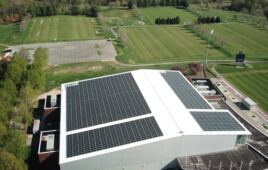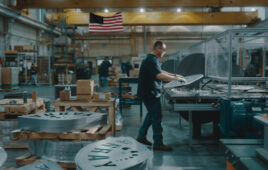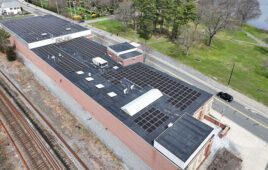
Photo courtesy of Yaskawa—Solectria Solar
Using high-capacity string inverters for small utility scale projects (less than 50 MW) has become a recent trend. However, there are still advantages to using central inverters for these projects.
Commissioning and maintenance: Commissioning and maintenance time and cost generally increase with the number of inverters .Because small utility projects usually require less units when using central inverters rather than string, commissioning can take less time for projects with central inverters. “During commissioning, every inverter needs DC input and AC output voltages verified, terminal torques confirmed and Modbus communications ID set,” said Eric Every, senior applications engineer at Yaskawa—Solectria Solar. “Additional time is necessary if there are specific voltage and frequency, or power factor settings required in the interconnection agreement.”
“Commissioning and preventative maintenance costs can increase significantly when there is a factor of ten more inverters in the PV plant,” Every continued. “If the string inverters have the same failure rate as central inverters, there will be ten times the number of service visits.”
Traditional central inverters require such onsite technician visits to order replacement parts and perform repair. But some new models have modular power converters that allow field replacement from those with little training, which minimizes lost energy production due to downtime.
“Economy of scale still comes into play in large utility scale projects when it comes to central inverter applications,” said Martin Beran, head of system support in Fronius’s Solar Energy Division. “Multi-watt installations create vast distances for the crews to cover to keep the system in good operating condition. Usually pathways are well developed and trucks can pull up right to the inverter pad. Therefore, bigger components and crews needed for servicing are not such an issue as on smaller sites. Difficult ground conditions, such as soft, muddy soil, might favor centralized power conversion from an O&M point of view. Also, a failing unit does not create such tremendous impact on energy production in large scale systems compared to single-digit-megawatt PV plants.”
Projects with long circuit runs: If circuit length exceeds about 250 ft Every noted it’s more cost effective to install DC circuits over AC circuits. Since the AC conductors operate at 480V they require larger conductors to achieve 1% voltage drop. “Keeping voltage drop low is important because voltage drop equates to system energy loss,” he said. “For utility-scale PV plants that require long runs, lower conductor costs make centralized solutions with combiner boxes much more attractive.”
System control and anti-islanding coordination: There are significantly less inverters to monitor and control when using central inverters. “These projects will typically use a plant master controller to provide a single communication interface with the utility,” Every explained. “That controller then distributes commands to all of the inverters. System control becomes more complicated and costly as the number of inverters increases. Also, anti-islanding coordination is more difficult with a higher inverter count.” Anti-islanding refers to detecting islanding—times when a distributed generator continues to power a location even when the electrical grid power from the utility is not present—and stopping power production since this can be dangerous to utility workers.




Fewer system components naturally makes for a higher reliability and up-time which leads to a better ROI and lower LCOE. This is true in all industries and the reason why inverters and integrated inverter stations/skids over time has been built in larger and larger powers. This is also favorable in order to run a solar installation as a full fled power plant with good grid-tie performance at a point of common connection. I am puzzled as to why the headline of this article says “small utility solar projects”. Everything is equally true for large ground mount utility solar projects. If solar panels are mounted in different directions (as sometimes on roofs) or otherwise exposed to uneven solar radiation due to e.g. shading or soiling the story could be different.